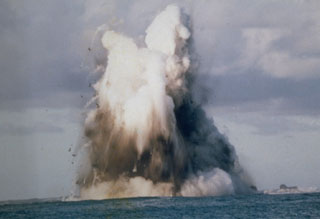Report on Nishinoshima (Japan) — 4 December-10 December 2019
Smithsonian Institution / US Geological Survey
Weekly Volcanic Activity Report, 4 December-10 December 2019
Managing Editor: Sally Sennert.
Please cite this report as:
Global Volcanism Program, 2019. Report on Nishinoshima (Japan) (Sennert, S, ed.). Weekly Volcanic Activity Report, 4 December-10 December 2019. Smithsonian Institution and US Geological Survey.
Nishinoshima
Japan
27.247°N, 140.874°E; summit elev. 100 m
All times are local (unless otherwise noted)
A thermal anomaly at Nishinoshima was identified in satellite images on 5 December, prompting JMA to expand the marine exclusion zone around the island to 1.5 km. The Japan Coast Guard (JCG) conducted an overflight the next day and observed Strombolian explosions ejecting blocks as high as 200 m above a crater on the E side of the central pyroclastic cone. Lava flows had traveled to within 200 m of the coastline. Light gray eruption plumes drifted E. During an overflight on 7 December observers confirmed continuing Strombolian activity and saw lava entering the sea.
Geological Summary. The small island of Nishinoshima was enlarged when several new islands coalesced during an eruption in 1973-74. Multiple eruptions that began in 2013 completely covered the previous exposed surface and continued to enlarge the island. The island is the summit of a massive submarine volcano that has prominent peaks to the S, W, and NE. The summit of the southern cone rises to within 214 m of the ocean surface 9 km SSE.
Sources: Japan Meteorological Agency (JMA), Japan Coast Guard

